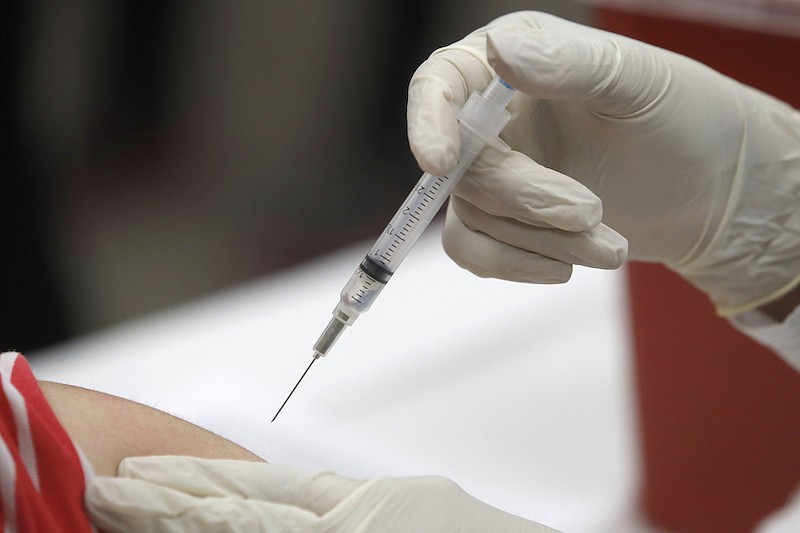ATLANTA - Public health officials are preparing for what could be challenging months ahead, when both the coronavirus and the flu are circulating, and they urge residents to do their part to help avert a crisis.
"The expectations are very scary," said Dr. Hugo Scornik, a pediatrician and president of the Georgia American Academy of Pediatrics.
The message to the weary public is the same as it's been for months: wear masks, socially distance from others, avoid crowds. But even more so than in the past, they say, it's important to get the flu shot.
Every year, there's a concerted campaign to coax people into taking the vaccine, with mixed success. About half of the U.S. population gets inoculated, and 5 percent to 20 percent contract the flu.
But what's sure to be an even more intense effort this year will face additional hurdles.
A lot of people are used to getting their flu shots where they work, or during annual medical checkups. But, because of the pandemic, many are now working from home, or reluctant to go to a doctor's office.
State health officials and doctors in Georgia said they are looking into creative ways to deliver vaccinations in a safe setting - maybe in the parking lots of grocery stores or churches, or curbside outside of doctors' offices.
COVID-19 and the flu are contagious respiratory illnesses that spread in similar ways, mainly through droplets when those who are ill cough, sneeze or talk. And the viruses share symptoms: fever, headache, cough, sore throat, muscle aches and fatigue.
That makes it often hard to initially differentiate between the two. COVID-19 is more contagious than the flu, and coronavirus-infected adults often get much sicker.
But even the run-of-the-mill flu can be dangerous and could strain resources if a wave of sick patients shows up in doctors' offices or at hospitals.
Worse yet, it's possible to get sick with COVID-19 and the flu at the same time. While it's not yet clear how the two viruses interact, doctors believe the flu could leave patients more vulnerable to a severe attack of COVID-19. Coming down with both at once could be devastating.
"Two epidemics hitting around the same time could be very, very bad," said Dr. Walt Orenstein, associate director of Emory Vaccine Center and professor of infectious diseases at Emory University School of Medicine. "You don't want to get COVID-19 and influenza. And you don't want to be recovering from one and then happen to get the other one on top of that. That's not good either."
Centers for Disease Control and Prevention Director Robert Redfield has warned that officials are bracing for a public health nightmare in the fall.
But, Redfield has said, if Americans wear masks, social distance, wash their hands, avoid crowds, and get their flu vaccines, it could be much better than the experts fear.
The start of the 2019-20 flu season was trending bad, but the number of cases in the United States dropped off considerably after the coronavirus emerged, possibly because people were being more diligent about handwashing and other measures to avoid getting sick.
Still, the flu season was hard on children. The CDC reported 188 pediatric deaths associated with the flu during a relatively mild U.S. season.
The risk of complications for healthy children, especially young children, is higher for flu than COVID-19, according to the CDC. Children with underlying health conditions face an increased risk for severe illness from both flu and COVID-19.
In Georgia, the last flu season claimed the lives of a total of 94 people and lead to more than 2,500 hospitalizations.
To try to predict the severity of this season, officials have monitored flu activity in Australia, Chile and other countries in the Southern Hemisphere.
While they reported low levels, experts pointed out many of them have stricter COVID-19 containment measures in place, which would also stop the spread of the flu. Here, restrictions are generally looser.
On the other hand, because of the pandemic, more Americans than ever before will be wearing masks during the flu season, which could help stanch the spread.
Producers are boosting supplies of the flu vaccine to meet what they predict will be a higher demand. CVS Pharmacy and MinuteClinic said they expect to administer 18 million vaccines, more than double the number last flu season.
Many health plans and employers cover the full cost of a flu shot. Otherwise, they generally cost between $30 and $40.
Federal health officials also have issued a directive to allow pharmacists in every state to give childhood vaccinations, including flu vaccines. Previously, vaccinations at pharmacies were allowed only for children 13 and older, but this latest directive allows pharmacies to immunize children as young as 3.
While some applaud the measure as a way to get more children vaccinated, the American Academy of Pediatrics called the measure "incredibly misguided," and said pediatricians' offices are open and safe. Families should go to the doctors they know and trust, the organization advises.
The CDC recommends that all people 6 months and older get a flu vaccination, with rare exceptions. It's particularly important for people who are at high risk of serious complications, including children under 2 years old, adults 65 and older, pregnant women, and those with medical conditions such as diabetes or heart disease.
September and October are good times to get the shot. The flu season typically begins in October, peaks between December and February, and usually ends in early spring. It can stretch into May.
After vaccination, it takes about two weeks for antibodies to develop in the body and provide protection.
The shot is usually effective in preventing flu infection in 40 percent to 60 percent of the people who take the vaccine, depending on how good a match it is to circulating flu strains.
But experts stress that, even if a person gets inoculated and contracts the flu, the vaccine can lessen the severity of the illness.
